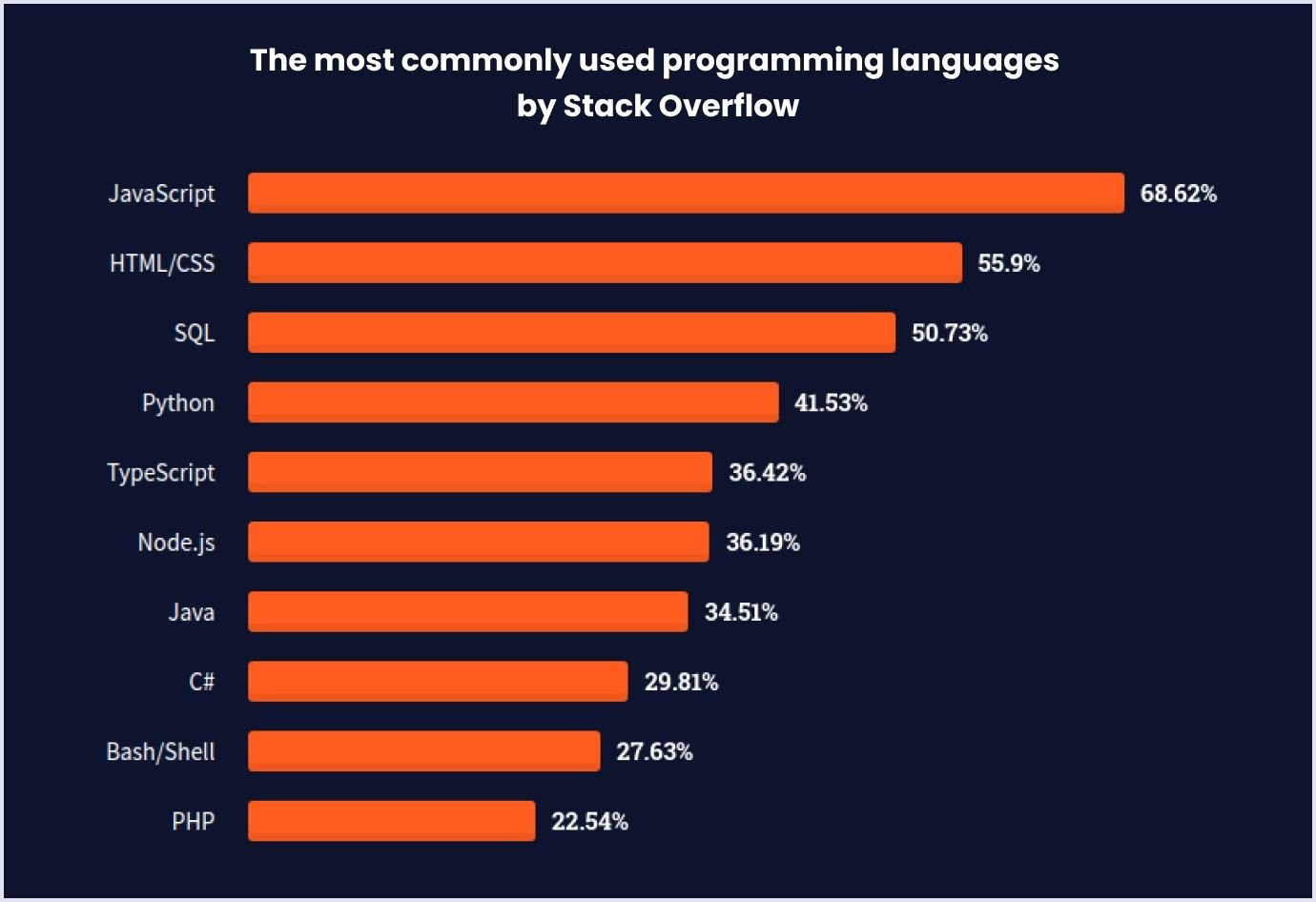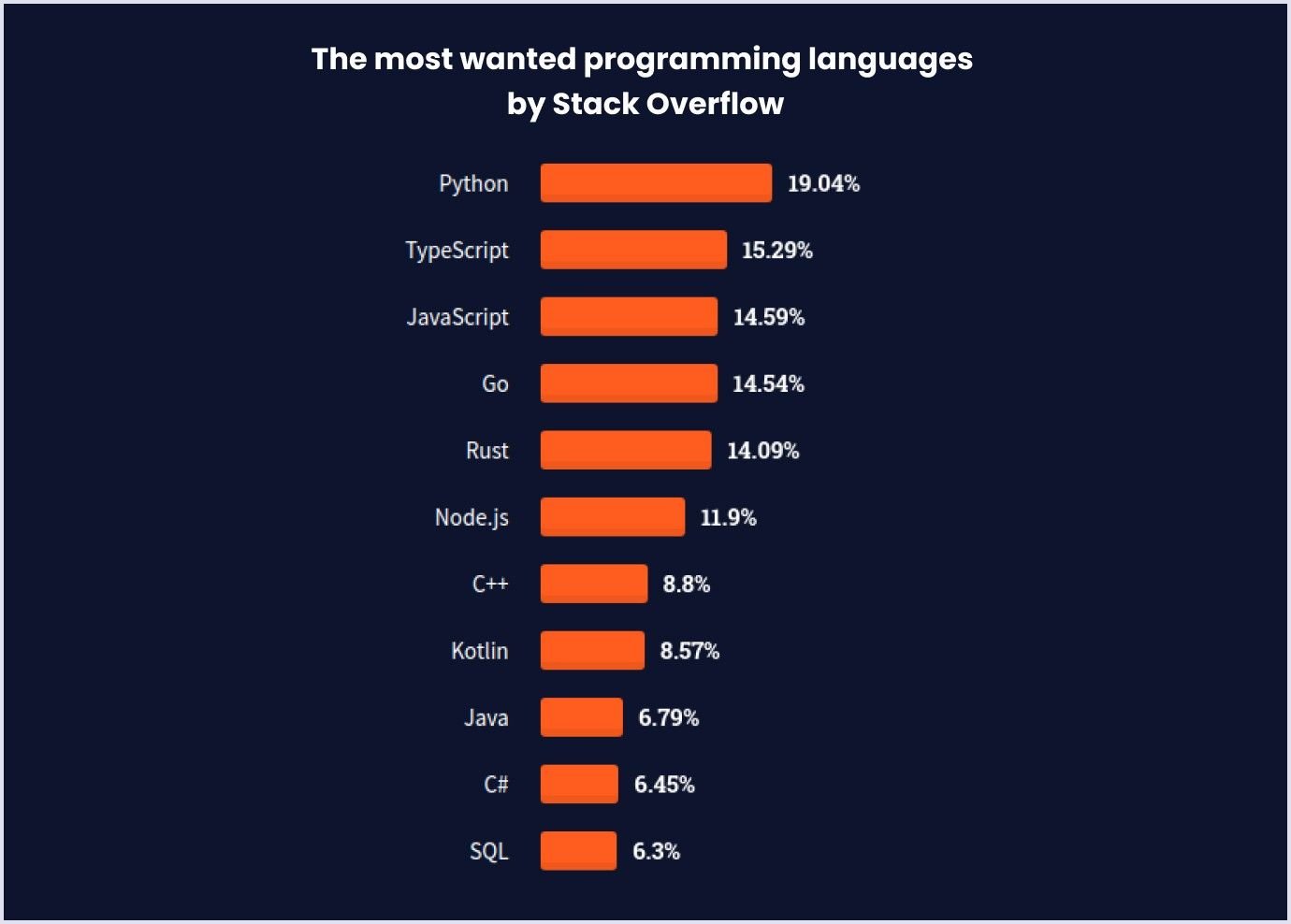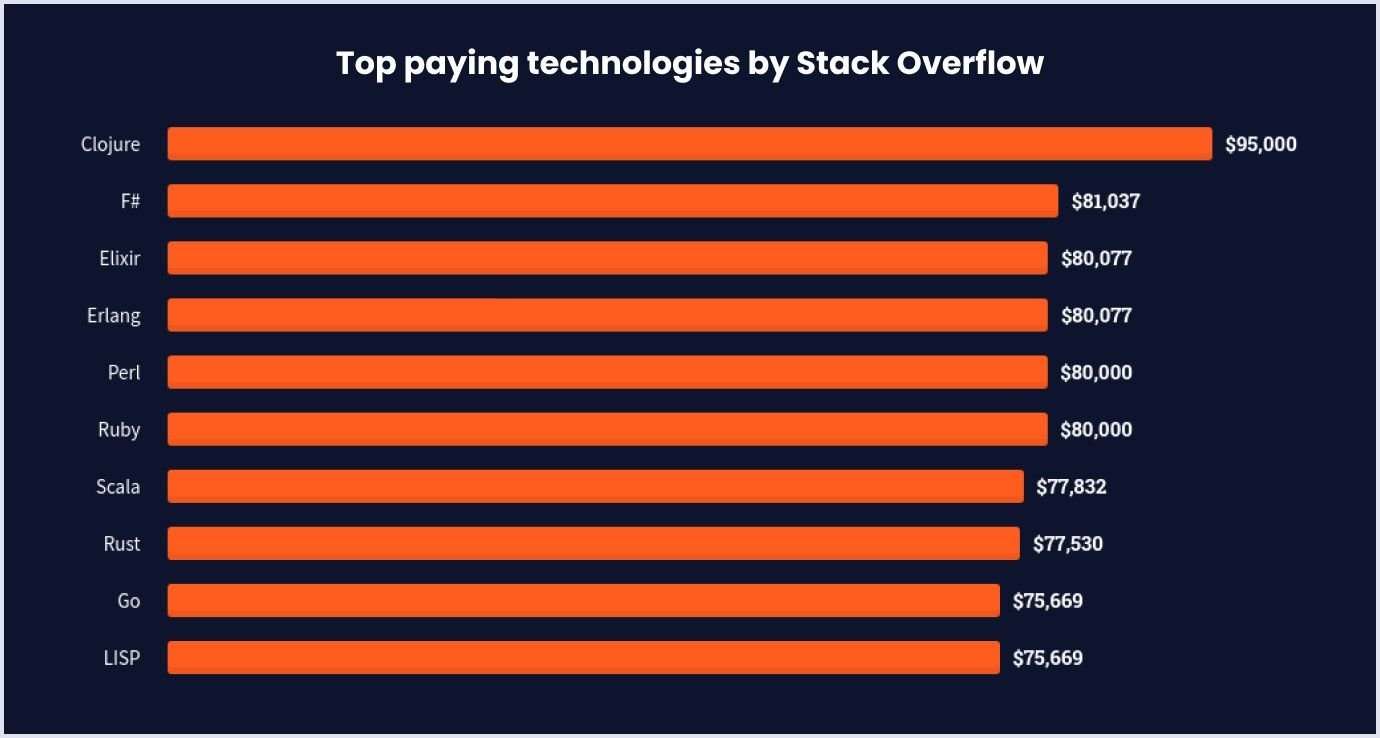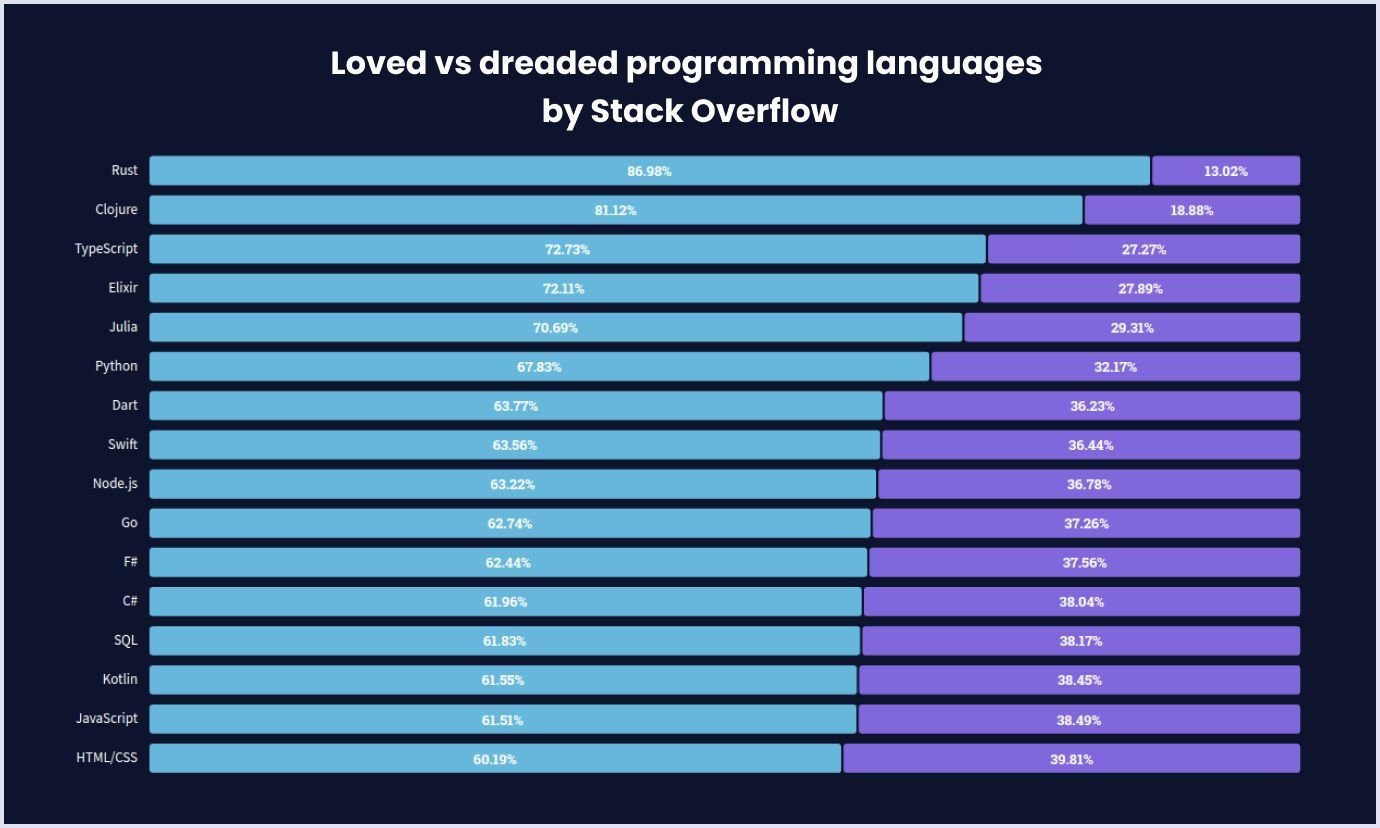The new year has come, and we all are excited to know what awaits the tech industry in the nearest future. What technologies will gain momentum? Which of them will become a thing of the past? What will be the best choice for building a web project in 2022?
To answer all these questions, we will provide you insights into trends in programming languages that you should not ignore in 2022.
Top programming languages to learn in 2022
JavaScript
Brandan Eich created JavaScript in 1995 while working at Netscape Communications. At that time, this computer services company launched the first popular web browser called Netscape Navigator. So Eich's task was to develop a programming language specifically for this browser.
At first, Javascript, now one of the top programming languages, was called Mocha. However, when Netscape united with Sun, the name was changed to JavaScript.
The popularity of JavaScript is undeniable. The survey by Stack Overflow showing current trends in programming languages proves this fact. Javascript is named a programming language that is the most commonly used by professional developers.

Source: Stack Overflow
Advantages
- Wide acceptance. JavaScript is considered one of the top programming languages for web development. W3Tech states that it is used as a primary front-end programming language for 97.8% of all websites found on the Internet.
- Server load. Being client-side technology, JavaScript reduces the demand on servers. The simplest applications may not require servers at all.
- Interoperability. JavaScript works well with other top programming languages and can be used in different types of applications.
Related reading: Top JavaScript Trends to Watch in 2022
Disadvantages
- There is no static typing. This drawback serves as a reason why it can be difficult to build large applications. However, TypeScript overlay can be used to make things better.
- Browser support. JavaScript is interpreted differently depending on the browser. For this reason, developers need to check their code on several browsers before releasing it.
- Insufficient client-side security. Users can view JavaScript code and use it for malicious purposes. For example, they can add code snippets to a website that compromises its data security.
Implementation area
JavaScript, being one of the top programming languages, can be used for various purposes, such as:
- Mobile app development;
- Web games;
- The front-end of web applications;
- The back-end of web apps;
- Desktop applications.
Recommended reading: How to Make a React Progressive Web Application (PWA)
Python
Python was created in the late 1980s by Guido van Rossum. Earlier, Guido has helped develop a general-purpose programming language ABC. It had some drawbacks, though the functionality was pretty decent. So Guido took the syntax and the best features of ABC and created a new scripting language to fix all those issues.
The growing popularity of Python has become one of the recent trends in programming languages. According to the survey by Stack Overflow, it is the first in the line of the top programming languages developers do not know but want to learn.

Source: Stack Overflow
So what makes Python so sought-after these days? Basically, simple learning, efficiency, and versatility serve as critical factors for its rapid growth. Besides, this top online web programming language is an excellent option for machine learning, data science, and the Internet of Things that have been growing faster recently.
Advantages
- Simplicity. Python has a syntax which is easy to read and understand. A flat learning curve makes this programming language a nice choice for beginners.
- A great number of libraries. With extensive Python libraries, developers no longer need to write the code from scratch. All functions required for performing basic tasks are already there.
- Open-source nature. Python is free to use and distribute.
Disadvantages
- Slow execution speed. Since Python code is executed line by line, the process is relatively slow. It means that this programming language will not work for projects where speed is a crucial factor.
- Great memory consumption. The flexibility of the data types makes Python's memory consumption pretty high.
- Uselessness for mobile development. Python is among the top web languages used mainly for building the server-side of apps. We rarely see it on client-side and mobile apps.
Implementation area
The latest software language trends show that the following domains can benefit from using Python.
- Medicine;
- Pharmacology;
- Neuroscience;
- Psychology;
- Biology;
- Astronomy.
Since Python is among the top languages for web development, plenty of famous websites are built with its help. For example, the tech giant Google considers Python one of their key programming languages alongside Java and C++. Many internal systems and Google App Engines use this programming language.
Another well-known example is Spotify. The server-side of the website contains lots of interdependent services. Up to 80% of them are built with Python.
Finally, Instagram uses Python programming language for their server-side.
You may also like: Avoid These Costly Mistakes During Web Application Development
Java
James Gosling developed Java in 1995. Initially, it was aimed at interactive television. However, the technology proved to be too advanced at that time, so it was used for Internet programming instead.
The key characteristics of Java as one of the top programming languages are as follows:
- Simple:
- Robust;
- Secured;
- Platform-independent;
- Object-oriented;
- Dynamic.
Advantages
- Platform independence. Developers can run Java code on any computer supporting Java Virtual Machine.
- Multithreading. The term thread is used for defining the smallest unit of a process. Consequently, multithreading means that several threads can run simultaneously. Multiple threads running independently of each other can increase an app's performance and efficiency.
- It is suitable for distributed computing. This notion means that a few computers on a network work together. It enables developers to build apps on the network that contribute to data and apps' functionality.
Disadvantages
- Slower performance. If we compare Java to other top programming languages such as C++ or C, we will notice that its performance is much slower.
- There is no backup facility. Since Java operates mainly on storage, it is not concentrated on the backup of the data. This is a significant drawback. It makes coders switch from Java to other technologies. This transfer became one of the most noticeable trends of modern programming languages.
- Code complexity. Code written in Java can be too verbose. It has a lot of long and complex sentences that can be challenging to read and understand.
Implementation area
Java is considered one of the top web languages. Other common uses of this technology include:
- Mobile applications;
- Big Data technologies;
- Software tools;
- Trading applications.
Related reading: 14 Top Web Development Trends to Outline 2022
Clojure
Rich Hickey created this dialect of Lisp in 2007. The name is based on the programming concept of “closure”. The letters C, L, and J stand for C#, Lisp, and Java, reflecting Clojure's design philosophy. It is based on Lisp functional programming, works on the Java platform, and allows concurrency.
Clojure developers have the highest median salary as most are experienced professionals. Also, the language is rarely used, so there are fewer specialists in this area than with popular programming languages.

Source: Stack Overflow
Advantages
- Simplicity. The members of the Lisp family share the same feature - simple syntax. Clojure's minimalism and consistency allow the easy transformation of code into data.
- Stability. Rich Hickey suggests that the language should develop steadily rather than through leaps. So the code with different language versions is likely to be compatible over the years.
- Dynamics. One of the latest programming trends is rapid prototyping. Clojure allows creating prototypes with overwhelming speed.
- Persistent data structures. Immutable data structures exclude side effects and ensure easy testing.
- Functions as values. The functional approach is a core feature differentiating Clojure from other Lisp dialects. Operating functions as values brings flexibility in customizing solutions.
- REPL. Clojure's REPL is an interactive development environment that runs the code in small steps, making it simpler to implement. It helps to handle complex computing operations balancing automation and improvisation in development. Programmers highly value Clojure for the feedback that REPL provides.
- Support of multiple development ecosystems. Clojure is compatible with Java Virtual Machine (JVM), .Net, and JavaScript. With access to these ecosystems, Clojure allows full-stack development with fewer bugs. This aspect ensures Clojure's growth along with major programming languages in 2022.
Disadvantages
- Redundancy. The other side of the non-breaking approach to Clojure’s design is accruing multiple ways to solve the same problem. Researching and understanding them might be confusing, especially for beginners.
- Not suitable for real-time solutions. Clojure cannot be used for real-time services where responsiveness is crucial.
- Lack of static typing layer. This brings a burden on testing the solutions and impedes large teams' work due to difficult code sharing.
- Poor bug reports. Developers note the complexity and obscurity of bug reports in Clojure.
Implementation area
The State of Clojure survey shows that this programming language is mostly used for web development, enterprise apps, and Big Data.
The top examples of companies using Clojure include Adobe, Apple, Facebook, Amazon, and SoundCloud.
Recommended reading: The Power of CSS Processors in Web Applications Development
Go
Go, which is a procedural programming language, appeared in 2007. Its creators are Google developers Robe Pike, Ken Thompson, and Robert Griesemer. Go was designed to make the software development process in Google more productive and scalable.
In 2009, developers resealed Go as an open-source project.
Jetbrains has released a survey covering the most significant programming languages trends. According to their findings, Go is one of the top programming languages developers were learning in 2021.
Mic Wlodkowski working as a Senior Front-End Developer at ContextFlow, gives his reasons for the increasing popularity of this programming language. He states that Go is capable of multithreading and concurrency. These concepts allow developers to create fast apps with simple code.
Advantages
- Easy to learn. Go ranks among top programming languages with a clean and easy-to-read syntax. Besides, it does not have many complex functions to learn. That is why this programming language is a good option for newbies.
- Great standard library. Go comes with a decent standard library, which makes the use of third-party libraries for such things as string manipulation, testing, and HTTP servers less required.
- Robust static analysis tools. Take gofmt as an example. This instrument formats the written code in compliance with the style suggested by Go. It means that your team gets more time to concentrate on the purpose of the code.
Disadvantages
- Limited packaging. Go offers a smaller number of packages compared to other ecosystems such as Ruby or Node.js. The thing is that its standard library has all the essential characteristics. Therefore, assistance from third parties is not required.
- Poor error handling. Developers need to use a repair error function if they expect any errors in their code. Also, they have to write many blocks to verify this mistake. As a result, developers get less clean code.
- Lack of frameworks. There is no major Go framework that developers can use. In this regard, it falls behind other top languages for web development such as Python, PHP, or Ruby that are famous for their great frameworks.
Implementation area
The latest trends in programming languages suppose using Go for the following products:
- Cloud development services;
- Media platforms;
- Google products;
- On-demand services.
Related reading: Pros & Cons of Using Ruby on Rails for Web Development
Kotlin
JetBrains introduced Kotlin in 2011. Previously, the company used Java to build tools for developers and project managers. However, repetitive work became a real challenge for the JetBrains team, so they started searching for alternative options. For some time, they used Scala, Clojure, and Groovy. However, these programming languages could not satisfy all their requirements. So the JetBrains team decided to create their language with all the features they needed.
Kotlin v 1.0 was officially released in 2016. The latest programming languages trends show it has been the fastest-growing programming language over the recent few years. It is largely because Google declared Kotlin the preferred technology for Android developers in 2019.
This newest programming language is used in almost 87% of top Android apps. The major release of Kotlin 1.5.0 in 2021 includes improvements that speed up implementations and debugging.
Advantages
- Good coordination with Java code. Kotlin is noted for its consistency with Java, its frameworks and tools. Given that, switching from one programming language (Java) to another (Kotlin) becomes less painful. Now, it's better with the new Java virtual machine (JVM) internal representation (IR) compiler.
- Fewer bugs. The codebase of Kotlin is clear and compact, and it leaves less room for mistakes.
- Easy maintenance. Kotlin is famous for its support for different IDEs, including Android Studio and SDK tools.
Disadvantages
- Slow compilation speed. Developers define slow compilation speed as a significant disadvantage of Kotlin. However, numerous tests show mixed results. Sometimes, Kotlin outperforms Java in regard to compilation speed. However, in some cases, Java is the winner.
- Limited resources. Though the number of developers switching to Kotlin is growing steadily, the community is still pretty small. It means that there are few resources for learning this programming language and resolving various queries.
- Kotlin is different from Java. These programming languages have a lot in common. Still, they have principal differences. So if you want to switch your Java-based Android app to Kotlin, your team will need additional training.
Implementation area
Kotlin is one of the best new programming languages, well suited for Android software development. In addition, according to the fresh programming languages trends, it can be used successfully for the following purposes:
- Building IoT applications;
- iOS application development;
- Web development;
- Data analytics;
- Data science;
- Game development.
Recommended reading: Progressive Web Apps vs Native Apps
Swift
Chris Lattner started working on Swift together with other Apple developers in 2010. The basic idea of a new programming language was taken from multiple technologies. They include Objective-C, Ruby, Python, Rust, and C#.
Swift, one of the emerging programming languages, was designed to replace Objective-C. The latter programming language has not seen any significant changes since the 1980s. Consequently, it lacked modern functionality.
Recent programming languages trends define Objective-C as one of the most dreaded languages at Stack Overflow.
Advantages
- Scalability. Swift projects are noted for their scalability. You can easily extend the existing functionality by adding new features when needed.
- Rapid development. Swift is among the top online web programming languages with a clean and expressive syntax. As a result, developers should write less code to perform regular tasks compared to Objective-C.
- Enhanced performance. Owing to excellent typing and error handling functions, developers can avoid major code crashes and errors. Besides, if there is a mistake in a code snippet, programmers notice and fix it immediately.
Disadvantages
- Insufficient support for older iOS versions. You can only use Swift to build mobile applications aimed at iOS 7 or later.
- Limited talent pool. Since Swift is one of the upcoming programming languages, it has a very limited community. It is growing steadily, but it is still small if we compare it to other languages. According to Stack Overflow, only 5.64% of professional developers use this technology.
- Instability. Developers noticed that Swift lacks backward compatibility with the release of each new version. Sometimes they have to rewrite their projects to stay relevant.
Implementation area
Swift is used for building macOS, iOS, watchOS, tvOS products.
You may also like: What Does Progressive Web Apps (PWA) Development Mean? [Definition]
Scala
Martin Odersky started working on Scala in 2001. In one of the interviews, he stated that the idea was to combine functional and object-oriented programming. Similar to other programming languages, Scala was created with a specific purpose in mind. According to Odersky, it was a desire to build more advanced language support for component software.
Increasing demand for Scala developers became one of the hottest programming languages trends.
Advantages
- Compatibility with Java. Coders can use JVM (Java Virtual Machine) and keep Java libraries.
- Functional coding. It allows for functional and object-oriented programming. Scala developers can write functional and concise code with its help. In addition, this programming language amplifies software development and testing.
- Scala is among the top web programming languages. Scala offers better coding and provides increased performance due to its complex features.
Disadvantages
- Steep learning curve. Some Scala features, such as functional programming and continuations, are less familiar for coders. Learning these approaches takes time. Besides, they say that Scala's syntax is more complicated when compared to Java.
- Limited developer pool. There are few coders who know Scala well. Therefore, finding the right specialist for your project can be challenging.
- It can be abandoned anytime. Since Scala is one of the emerging programming languages, there is a risk that it will not “make it.” However, you should not worry about it since the number of big names switching to Scala grows steadily.
Implementation area
Scala programming language can be used for different purposes. It works well for different types of custom business software development projects. They include Big Data and distributed applications. So Scala stays among the programming languages of the future.
When it comes to well-known websites built with Scala, we should mention LinkedIn, Twitter, Tumblr, and Foursquare.
Recommended reading: How to Build an Auction Website Like eBay
Rust
Rust was created in 2010 as an alternative to C++ by a Mozilla employee Graydon Hoare. Syntactically similar to C++, Rust provides better performance, safer memory management. Hence, the name's choice, which is a substring of “robust”. Now, the independent Rust Foundation manages its open-source code base.
Rust shines as the most loved language for the sixth year in a row. Let's see why it holds a prominent position among the modern programming languages.

Source: Stack Overflow
Advantages
- Safe and unsafe Rust. These two modes of writing in Rust represent if the solution is secure. Safe Rust puts limitations on development compared to unsafe Rust. For example, safe Rust implies object ownership management. But it creates the trusted code with guaranteed memory safety.
- Elimination of memory bugs and incorrect operations at compile time. Rust includes the borrow checker that removes memory bugs when writing the code. So, garbage collection is not needed with such swift clearing of the memory space.
Also, Rust informs on any fault operations with objects. Thus, the bugs are detected as early as possible, saving time and cost for removing them when the code is finished or launched. This peculiarity distinguishes Rust among the programming language trends in 2022.
- Compatibility with other languages. Other programming languages can use the Rust projects as libraries. This is helpful when replacing the software parts where high performance and memory safety are essential.
Disadvantages
- Many error messages while coding. Error messages in Rust appear while you're writing the code. This might be not very pleasant. Still, they are a precious source of information that enables you to correct your code at early stages.
- Steep learning curve. It takes some time to master this language. Also, you need to know C++ or another object-oriented programming language to start working with Rust.
Implementation area
Rust is used for the development of game engines, file systems, browser components, and VR simulation engines. Many companies use Rust in production, including Mozilla, npm, Dropbox, and Figma.
There are some more impressive facts about this programming language. Microsoft explores it for building the components of Windows and Azure. Google attempts to build parts of the Android operating system with Rust. AWS's Firecracker that processes trillions of requests monthly is built with Rust only.
Recommended reading: Useful Git Commands that Save Time
Ruby
Last but not least, we want to discuss the Ruby programming language. Being a software development company specializing in Ruby and Ruby on Rails, we could not ignore this technology.
Yukihiro Matsumoto invented Ruby in the mid-1990s. He came up with the idea of building a programming language that could increase developers' productivity.
Though current programming language trends show a decline in its popularity, the demand for Ruby still remains. This brings the language to the top paid technologies. The Ruby team works on enhancements to ensure better performance of the solutions created with this technology.
Advantages
- A great number of gems.Ruby gems are ready solutions that can extend the existing functionality. It means that coders do not have to write code from scratch. In this regard, gems speed up web product development significantly.
- Ruby is an object-oriented programming language. So developers can build, debug, reuse, and maintain software products easily.
- Elegant syntax. Ruby is noted for its simplicity and readability. Developers can read and understand code written in this programming language effortlessly.
Disadvantages
- Poor debugging. Ruby code can be challenging to debug. The main reason is that it generates bugs at runtime.
- Low speed. Low speed has been defined as the main drawback of the Ruby programming language. However, version 3.0 and higher have significant improvements in this regard.
- Decrease in popularity. The latest trends in programming languages show that Ruby is less popular than other top programming languages.
Implementation area
Ruby is actively used for building custom marketplace websites. The most popular examples of marketplaces created with Ruby are Airbnb, Fiverr, and Couchsurfing.
Besides, Ruby is a perfect option for the following types of web projects:
- SaaS custom software;
- Prototyping;
- Custom database solutions;
- Content management solutions.
Related reading: SaaS Product Development: Why Choose Ruby on Rails Framework
Conclusion
As you can see, the future of the software development industry looks very promising. Current trends in programming languages show that there is a wide selection of top programming languages for any software development project.
Your ultimate choice depends on the type of application you are going to build and specific business requirements.
Are you looking for a company offering the best custom software development services? Feel free to contact us. We will eagerly take up your project.

